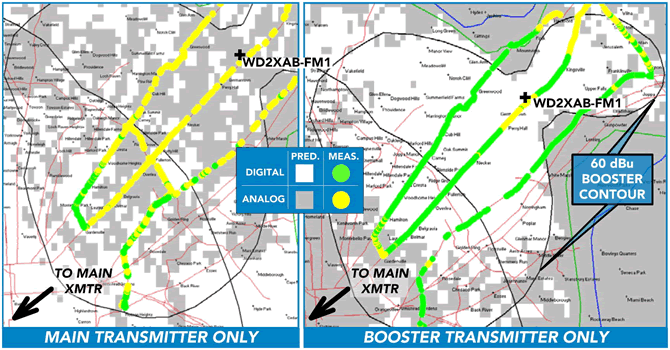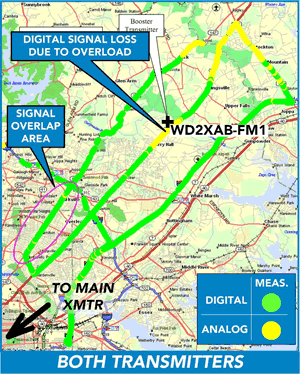
|
FASTROAD Releases Interim FM IBOC Digital Booster Report 
A technical report containing the interim results of an FM IBOC digital booster test program was released by NAB FASTROAD on November 10. This work has been undertaken by iBiquity Digital Corporation, developers of the HD Radio IBOC system used by U.S. broadcasters to transition to digital radio, and is being co-funded by iBiquity and FASTROAD. Release of this report follows a recent discussion of this topic by iBiquity at the IEEE Broadcast Symposium, held in October in Alexandria, Va. (see the October 25, 2010 issue of Radio TechCheck for additional information). These interim results have been obtained using experimental station WD2XAB (Columbia, Md., 93.5 MHz, 1.5 kW ERP analog, 150 W ERP digital, 456 ft HAAT) and booster WD2XAB-FM1 (Kingsville, Md., 50W ERP digital, 446 ft HAAT) which is located approximately 20 miles away from the main transmitter. For these tests, iBiquity is using transmission equipment modified so that, among other things, both transmission signals have identical frequency and “state synchronization” so that the transmitted signals are identical. Prior to conducting measurements in the field, iBiquity ran computer propagation prediction software to characterize the expected reception conditions for the main and booster transmitters when operated individually, and for when both signals were present. The first two figures shown here, taken from Figures 4-1 and 4-2 in the report, show the propagation study results for each transmitter operating individually as well as actual measured results obtained on test runs using an IBOC receiver. 
The white and gray squares in the figures are the computer prediction of where an IBOC receiver would successfully capture the digital signal (white squares) or where the receiver would have blended to analog (gray squares). Also shown on each map is the 60 dBu predicted contour of the booster transmitter. Note that the booster is using a directional antenna which is not uncommon for booster applications, since boosters are often placed at the edge of a station’s coverage area and then, using directional antennas, “pointed back” towards the main transmitter to “fill-in” coverage areas that are lost due to, for example, terrain shielding. The green and yellow dots in the figure are actual IBOC receiver performance as measured during test runs, for the case where the main transmitter only is on (left map) and where the booster transmitter only is on (right map). Note that in the main transmitter only case, as the test receiver moves away from the main transmitter, the receiver blends to analog (yellow dots) and for the most part stays that way for each path tested. When only the booster is on, however (right map), on those same paths there is good digital reception (green dots) where the receiver had previously blended to analog (for the main transmitter only case). 
In the final figure, test results obtained when both transmitters were operating are shown. These results were obtained after the main and booster signals were time-aligned for best overall performance, as described in the report. Note that the signal loss near the booster site indicated on this map was due to an RF overload condition in the test receiver and was a consequence of amplifiers used in the test setup. An IBOC receiver being operated normally (not part of an experimental setup) would not experience a digital outage at this point. iBiquity’s testing at WD2XAB involved both digital coverage testing as well as analog compatibility testing, to examine the potential interference from the digital sidebands on the host analog signal near the booster site. Digital coverage performance results have been very encouraging and iBiquity reported that no destructive interference of the digital signals was encountered. Tests have shown that some receivers may experience interference to the analog host (due to the digital-only booster) at digital-to-analog power ratios below 0 dBc. Additional testing is currently underway at Greater Media station WKLB (Waltham, Mass., 102.5 MHz, channel 273B). As part of these additional tests, iBiquity intends to experiment with adding a small analog signal component to the digital booster output to see if this mitigates any host interference in the vicinity of the booster, while at the same time not adversely affecting analog reception at greater distances. NAB FASTROAD (Flexible Advanced Services for Television & Radio On All Devices) is the technology advocacy program of the National Association of Broadcasters. The overall mission of the FASTROAD program is to seek and facilitate development and commercialization of new technologies that can be exploited by broadcasters using radio and television broadcast spectrum. A copy of the digital booster interim results test report is available for download free-of-charge from the FASTROAD web site at www.nabfastroad.org. |
|
The November 15, 2010 Radio TechCheck is also available in an Adobe Acrobat file. Please click here to read the Adobe Acrobat version of Radio TechCheck. |

